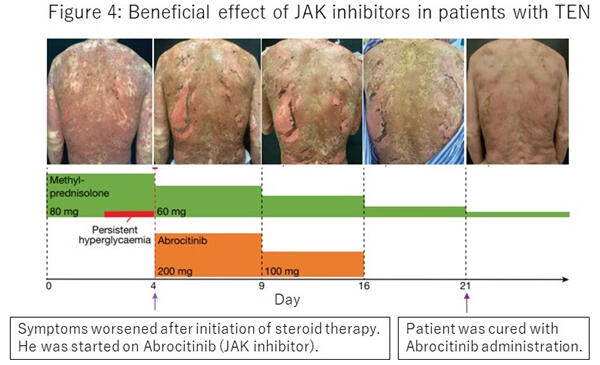An international joint research group led by Assistant Professor Akito Hasegawa and Professor Riichiro Abe of the Division of Dermatology, Niigata University Graduate School of Medical and Dental Sciences, and Professor Matthias Mann of the Max Planck Institute of Biochemistry in Germany have announced that they developed a new treatment to improve the prognosis of toxic epidermal necrolysis (TEN), a severe drug-induced skin reaction. They used spatial proteomics to show that the inflammation-causing JAK/STAT pathway is deeply involved in the pathogenesis of TEN. They also confirmed that treatment with JAK inhibitors, which block this pathway, produced favorable outcomes in seven TEN patients. The findings are expected to contribute to the improvement of the prognosis of TEN. The results were published in Nature on October 16.

Provided by Assistant Professor Hasegawa and Professor Abe of Niigata University
TEN is a severe allergy caused by various drugs and is a designated intractable disease as it is a fatal disease characterized by necrosis of the skin and mucous membranes throughout the body. According to clinical practice guidelines, systemic administration of steroids is the first-choice treatment, and intravenous immunoglobulin and plasma exchange therapy are used for refractory cases. However, the survival prognosis is very poor, with a mortality rate of 30%. Meanwhile, the mechanism of pathogenesis remains largely unclear.
In this study, the research group used deep visual proteomics, a technology combining high-performance microscopy, mass spectrometry, and AI analysis to accurately quantify the proteins contained in single cells. Analysis of skin tissue from TEN patients revealed a marked increase in the JAK/STAT pathway, which is responsible for intracellular transmission of information about inflammation, cell proliferation, and differentiation and causes inflammation. Drugs that inhibit this pathway have already been developed for diseases such as atopic dermatitis and rheumatoid arthritis. Therefore, JAK inhibitors were administered to mouse models of TEN pathology, and TEN-like symptoms were suppressed.
Next, patients with TEN were treated with JAK inhibitors, and all seven patients were cured rapidly without major side effects. Moving forward, the research group will conduct larger-scale clinical trials to verify safety and efficacy and put the treatment method into practical use.
Hasegawa said, "TEN is a severe drug-induced skin reaction with a high mortality. The pathogenesis of the disease still remains largely unknown, and appropriate treatment methods have not been established. In this study, we found that the JAK/STAT axis is involved in the pathogenesis of TEN and that JAK inhibitors may be effective therapeutic agents. We will continue our research to save as many patients suffering from this disease as possible."
Journal Information
Publication: Nature
Title: Spatial proteomics identifies JAKi as treatment for a lethal skin disease
DOI: 10.1038/s41586-024-08061-0
This article has been translated by JST with permission from The Science News Ltd. (https://sci-news.co.jp/). Unauthorized reproduction of the article and photographs is prohibited.




